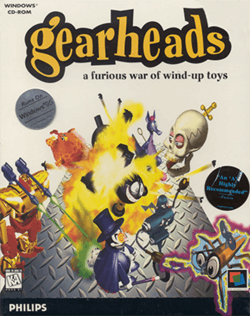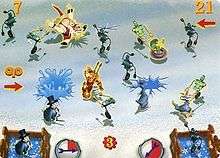Gearheads
| Gearheads | |
|---|---|
 | |
| Developer(s) |
Philips Media, R/GA Interactive |
| Publisher(s) | Philips Media |
| Producer(s) | Stacy Koumbis |
| Designer(s) |
Frank Lantz, Eric Zimmerman, Christopher Erhardt |
| Platform(s) | Macintosh, Microsoft Windows, Philips CD-i, SNES |
| Release | 1996 |
| Genre(s) | Strategy |
| Mode(s) |
Single-player, Multiplayer |
Gearheads is a strategy video game released in 1996 by Philips Media for Microsoft Windows, the Macintosh, CD-I and SNES. The player deploys toys in order to get them across an arena while attempting to prevent toys from crossing from the other side, and can play against the computer or another player. Singe, customisable games can be played, or the player can play a series of games with set rules and a limited number of lives in a tournament. Reception was mixed, with some reviewers praising the addictiveness and others criticising the sounds and artificial intelligence.
Gameplay

The game is played by releasing toys on an arena, with the goal of getting them to the other side, and prevent their opponent's toys from reaching the player's side.[1] Toys are "charged" by waiting before release, and stop if they run out of energy.[2] The toys are of different kinds (such as robots, Santa Claus, and magicians) with certain movement patterns and abilities such as destroying other toys or making them turn around. Some toys are primarily intended for offence, others defence.[3] The player can switch between the available toys at any time. Once released, players have no direct control over them, and they do not belong to a player: a toy leaving the arena via the left side scores a point for the player on the right side and vice versa.[4] The first player to score 21 points wins, unless he is only ahead by one point, in which case the game continues until there is a two-point difference between the scores.[5] There is an unlimited supply of toys, and they are released on a row in the arena.[6] Toys can be recharged by Handy, a glove toy.[7]
There are four main arenas: kitchen, garden, frozen pond, and factory. The kitchen has no obstacles. The garden's main obstacles are bugs. The frozen pond's main obstacles are cracks in the ice which, if crossed over enough times, become holes that destroy toys that fall into them. The factory has obstacles such as conveyor belts, teleporters, and stoppers.[8] Occasionally, a metal item will appear on one side of the arena. When crossed, a powerup is granted to the other player. Powerups include a rocket, being able to release toys from halfway across the arena, and the opponent being unable to do anything. Most powerups last only for a limited time.[9]
There are two game modes: tournament and duel. In tournament, the player is assigned a selection of four toys and must defeat the computer-controlled opponent. Every three victories, there is a challenge in a special arena where the player must defeat the opponent with only one toy. A life is granted if won (the player starts with three). Duel is where the player can practise a game against either a computer opponent or another player. Which arena the game takes place in, the number of toy types allowed and which are used, the difficulty level, and whether powerups are available can be customised.[10]
Development
Gearheads was designed by Frank Lantz, Eric Zimmerman at Philips Media.[11][12] The game was produced by Philips and R/GA Interactive.[13] Art and animation were handled by Susan Brand Studios.[12] The Windows and SNES versions were released in 1996.[14][15]
Reception
| Reception | ||||||||||||||
|---|---|---|---|---|---|---|---|---|---|---|---|---|---|---|
| ||||||||||||||
Gearheads received mixed reviews. The game's addictiveness was lauded by PC Zone, who said it features the planning aspects of Tetris and plenty of options, including "bizarre" powerups.[16] Steve Wartofsky of Computer Games Strategy Plus said that Gearheads is just what it claims to be: "a furious war of wind-up toys".[17] Michael Bertrand of Gamer's Zone praised the addictiveness, but criticised the "repetitive" sound and music and the game only having four arenas.[18]
Mike McGrath of Coming Soon Magazine criticised the game as "far too mindless" and described the sound and music as "annoying".[19] PC Gamer's Dean Evans, despite complimenting the "pretty" graphics, said Gearheads has a "childish" nature and is "dull and overpriced".[14] Reviewing the SNES version, Air Hendrix of GamePro praised the graphics as colourful and humorous, but criticised the "moronic" artificial intelligence.[15]
References
- ↑ Manual, p. 5.
- ↑ Manual, p. 6.
- ↑ Manual, pp. 7-9.
- ↑ Manual, p. 5.
- ↑ Manual, p. 6.
- ↑ Manual, pp. 6,10.
- ↑ Manual, pp. 7,8.
- ↑ Manual, pp. 9,10.
- ↑ Manual, p. 10.
- ↑ Manual, pp. 6,10.
- ↑ Salen, Katie; Zimmerman, Eric (2003-10-01). Rules of Play. MIT Press. pp. 166–168. ISBN 978-0-262-24045-1.
- 1 2 Manual, p. 63.
- ↑ Gearheads Box (Europe ed.). Philips. 1996. p. back.
- 1 2 3 Dean Evans (July 1996). "Gearheads". PC Gamer. No. 32. Bath: Future plc. p. 78. ISSN 1470-1693.
- 1 2 "Gearheads" (PDF). GamePro. No. 99. IDG. December 1996. p. 158. ISSN 1042-8658. Retrieved 2017-02-05.
- 1 2 "PC Review: Gearheads". 2001-10-13. Archived from the original on 2007-10-12. Retrieved 2017-02-05.
- 1 2 Steve Wartofsky (1996). "Gearheads". Computer Games Strategy Plus. Archived from the original on 2003-08-17. Retrieved 2017-02-05.
- 1 2 Michael Bertrand (1997). "A Review of Gearheads". World Village. Archived from the original on 2009-03-01. Retrieved 2017-02-05.
- 1 2 Mike McGrath (1996). "Gearheads by Philips Media". Coming Soon Magazine. Retrieved 2017-02-05.
Sources
- Philips (1996). Gearheads PC/Mac manual (Europe ed.).